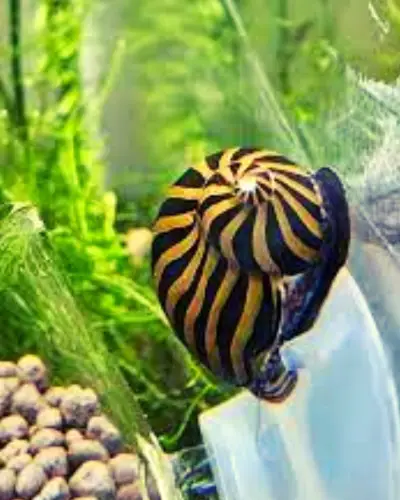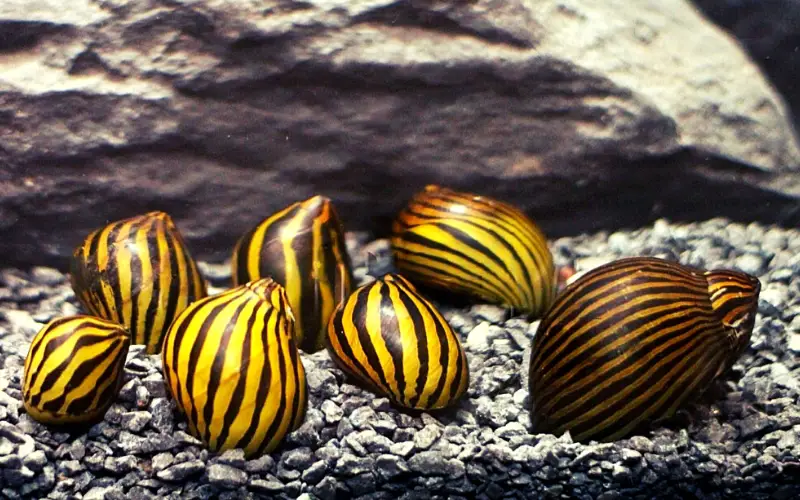Are you a beginner in aquarium keeping and looking for an easy-to-care-for aquatic creature to add to your tank? Look no further than the Zebra Nerite Snail!
These adorable little snails are perfect for beginners and can bring a fascinating touch to your underwater world.
Known for their striking black and yellow striped shells, Zebra Nerite Snails are not only visually appealing but also serve as efficient algae-eaters.
They can help keep your tank clean and free from excess algae growth, making them a valuable addition to any aquarium.

This ultimate beginner care guide will delve into all the essential aspects of caring for snail zebra. From tank setup and water conditions to feeding and maintenance, we will provide you with the knowledge and tips to keep your snails healthy and happy.
Whether you are a beginner or an experienced aquarium keeper, this guide will help create a thriving environment for your Zebra Nerite Snails. So, let’s dive in and explore the wonderful world of Zebra Nerite Snails!
Table of Contents
ToggleZebra Nerite Snail Overview:
Zebra Snails, also known as nerites, are a popular addition to freshwater aquariums. These snails may be small, but they play a significant role in maintaining a healthy tank ecosystem.
Zebra snails require a pH level that is slightly on the higher side and are known for their ability to climb glass and consume enough algae to keep the tank clean.

Although they primarily feed on algae, it is recommended to supplement their diet with algae wafers to ensure they receive enough food. Zebra snails are not difficult to care for, but breeding nerite snails can be a challenge.
Therefore, they are more commonly found in the aquarium hobby as wild-caught rather than bred in captivity. These snails are native to freshwater habitats in the South, although they can also adapt to salty water.
They have distinctive black stripes around their shells, which makes them a visually appealing addition to any tank. It is essential to provide a tight-fitting lid for the aquarium as zebra snails are known to crawl out of the water.
Compatible Species of Snail Zebra Gastropod
The zebra snail, the Malaysian trumpet snail (Melanoides tuberculata), is a famous freshwater aquarium snail known for its striped shell and algae-eating abilities. When considering compatible tankmates for your snail zebra, it’s important to remember that:
- Zebra snails are peaceful herbivores. They are generally good community members and won’t bother other fish or invertebrates.
- They are prolific breeders. If you don’t want a snail explosion, keep only a few or consider methods to control their population.
- They are active burrowers. They need a soft substrate like sand or gravel to thrive.
Here are some snail species generally considered compatible with zebra snails:
Other Herbivores:
- Mystery snails (Pomacea bridgesii): These large, colorful snails are peaceful and help control algae growth.
- Nerite snails (Neritina spp.): These salt water snails can tolerate freshwater for extended periods and are excellent algae eaters. Choose a small species, like the zebra nerite (Neritina natalensis).
- Ramshorn snails (Planorbidae spp.): These tiny, fast-moving snails come in various colors and patterns and help clean up green spot algae.
Peaceful Scavengers:
- Malaysian trumpet snails (Melanoides tuberculata): You can keep zebra snails with their kind! Just be aware of their breeding potential.
- Malaysian shrimp snails (Brotia pagodula): These tiny, interesting snails feed on detritus and biofilm, helping keep the tank clean.
- Assassin snails (Cleopatra bulimoides): While primarily snail-eaters, they won’t bother zebra snails due to their hard shells. Only add them if you have a snail overpopulation issue.
Things to Avoid:
- Aggressive fish: Large, predatory fish like cichlids or oscars will likely eat your zebra snails.
- Competitors for food: Other herbivorous fish like goldfish or plecos might outcompete the snails for food.
- Snail-eating invertebrates: Loaches, crayfish, and some crabs will readily snack on zebra snails.
Remember, even compatible species can sometimes have individual differences in temperament. Constantly monitor your tank for signs of aggression or stress and adjust accordingly.
Recommended Tank Parameters for Zebra Nerite Snails
When caring for Zebra Nerite Snails in an aquarium, it is essential to provide them with the proper tank parameters to ensure their well-being.
These snails are primarily herbivorous and will use plants as a food source. Therefore, having live plants in the aquarium is highly recommended.
Additionally, Zebra Nerite Snails will lay eggs on various surfaces in the tank, so it is crucial to provide them with suitable places to do so. High water quality is critical for these snails, as they are sensitive to ammonia and nitrate levels.
However, they can adapt to various water parameters, making them versatile and easy to care for. While breeding Zebra Nerite Snails in captivity is difficult, they are readily available in the aquarium trade.
These snails are adapted to brackish water but can also live in fresh water environments. Please note that a healthy diet and proper care can help promote optimal shell growth and ensure the longevity of these fascinating creatures.
Breeding Zebra Snail in Aquarium
Breeding Zebra Snail in an aquarium can be a rewarding and fascinating experience for amateur and experienced fishkeepers. These small, striped snails are a popular addition to freshwater tanks as they are known to be efficient algae eaters.
To successfully breed Zebra Snails, it is essential to recreate a suitable environment that mimics their natural habitat. This includes providing ample hiding spots and vegetation for the snails to lay their eggs.
Temperature and water quality should also be carefully monitored to ensure optimal conditions for breeding. In terms of care, it is vital to maintain a proper balance in the aquarium, as excessive algae can limit the snails’ ability to reproduce.
Many hobbyists recommend introducing a small group of freshwater snails to increase the chances of successful breeding. While there is no guarantee of successful breeding, providing the right conditions and care can significantly improve the likelihood of raising healthy Zebra Snail offspring in the aquarium.
Commonly Asked Questions about Snail Zebra Species (FAQs)
Are zebra nerite snails asexual?
No, zebra nerite snails are not asexual. They have distinct male and female sexes, but breeding them in captivity is difficult due to specific larval requirements.
What to feed zebra nerite snails?
Zebra nerites munch on algae first! Supplement with blanched veggies (zucchini, spinach) or algae wafers if algae’s scarce. Avoid copper-treated fish foods!
Are zebra snails nerite snails?
Yes, zebra snails are a type of nerite snail! They’re named for their distinctive black and white stripes and are known for their excellent algae-eating abilities.
Can figer nerite snails and zebra nerite snails breed?
No, fig nerite and zebra nerite snails likely can’t breed. While both are nerites, they’re different species and require specific breeding conditions unlikely in aquariums.
Where to find zebra nerite snails for sale?
You can find Zebra Nerite snails for sale at reputable aquarium stores, online fish retailers, or through classified ads from hobbyist communities and online marketplaces.
Can zebra snails and nerite snails mate?
While both are called “nerite snails,” zebra and other nerite species likely can’t breed. They’re different species with specific needs for successful mating.
Are Zebra Nerite snails good?
Absolutely! Zebra Nerites are algae-gobbling champs, safe for plants, peaceful, and rarely overpopulate your tank. Just be sure they have enough algae or veggie snacks!
What do zebra nerite snails eat?
Zebra Nerite snails primarily eat algae, biofilm, and decaying plant matter in aquariums, making them excellent natural cleaners.
How big does a zebra nerite snail get?
Most zebra nerite snails stay tiny! Expect them to reach just 1/2 to 1 inch in diameter, making them perfect for even smaller planted tanks. The occasional big eater might hit 1.5 inches, but that’s rare.
How long do zebra nerite snails live?
Zebra nerite snails typically live 1-2 years, happily munching algae and keeping your tank clean. Some thrive even longer with proper care!
Do Zebra Nerite snails lay eggs?
Yes, snail zebra lay eggs above the water line. The zebra nerite snail eggs are small, white, and round, typically attached to aquarium walls, decorations, or even the aquarium lid.
Do Nerite snails need brackish water?
No, Nerite snails do not require brackish water. They are freshwater snails and can thrive in freshwater aquariums without brackish conditions.
Conclusion
In conclusion, the Zebra Nerite Snail is a fascinating creature that thrives in fresh and saltwater environments. Its unique pattern of black and yellow stripes makes it easily identifiable and adds a touch of beauty to any aquarium or tank. This snail is not only visually appealing, but it also serves a practical purpose by helping to keep the tank clean. Zebra Nerite Snails are proficient algae eaters and eagerly consume any excess algae growth in the tank. This not only benefits the overall appearance of the tank but also helps to maintain a healthier environment for the other inhabitants.
The Zebra Nerite Snail is a peaceful and low-maintenance pet that does not require much attention or specialized care. However, providing them with a stable water temperature and proper water conditions is essential to thrive. Overall, the Zebra Nerite Snail is a great addition to any aquatic setup and will bring its owner joy and fascination.
You might also like
- The Best Zebra Nerite Snail Temperature (Expert Care Guide)
- Nerite Snail Food 101: Care Guide for Healthy Aquarium Snail
- Tiger Nerite Snail 101: The Only Care Guide You’ll Ever Need
- TOP 5 Best Snails for Betta Tank: (That Can Live Safely)
- Nerite Snails Water Parameters: (Experts Care & Tank Set Up)
- What Do Nerite Snail Eggs Look Like (Prevent Overpopulation)




